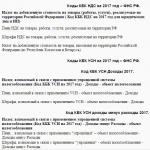Kbk for payment of VAT c. KBK VAT penalties for legal entities
When transferring VAT to the budget, payers must indicate in field 104 of the payment order (Appendix 3 to Bank of Russia Regulations 06/19/2012 N 383-P) the BCC corresponding to this tax. All necessary budget classification codes are given in Order of the Ministry of Finance dated July 1, 2013 N 65n.
KBK VAT-2018 for legal entities
When filling out a payment order for payment of the tax itself, the VAT payer must reflect the KBK 182 1 03 01000 01 1000 110.
KBK penalties for VAT 2018
The BCC for paying penalties on VAT differs from the BCC for the tax itself in the 14th and 15th categories. To obtain the BCC for paying penalties, it is enough to replace the 14th category from “1” to “2”, and the 15th - from “0” to “1”. That is, VAT penalties must be transferred to KBK 182 1 03 01000 01 2100 110
VAT penalty: KBK
When paying a VAT fine, the 14th KBK category for tax changes from “1” to “3”. The BCC for a VAT fine looks like this: 182 1 03 01000 01 3000 110.
KBK VAT for individual entrepreneurs
There are no separate BCCs for VAT for individual entrepreneurs - they use the same budget classification codes as legal entities.
KBK VAT: tax agent
When transferring VAT as a tax agent of an organization or individual entrepreneur, you must indicate in the payment order the same BCC as for a simple VAT payer - 182 1 03 01000 01 1000 110.
The tax agent reflects the usual BCC for VAT in the payment slip and when paying penalties or fines ( 182 1 03 01000 01 2100 110 or 182 1 03 01000 01 3000 110 respectively).
Please note that although both VAT payers and tax agents use the same KBK, the status in the payment slip (field 101) is set differently: tax agents must indicate the status “02” (Appendix No. 5 to Order of the Ministry of Finance of Russia dated November 12, 2013 N 107n) .
KBK VAT: imports from EAEU countries
Organizations and individual entrepreneurs importing goods from EAEU countries, when paying import VAT, as well as penalties and fines on it, must indicate in field 104 of the payment order one of the following BCCs:
When importing goods from countries other than the EAEU, VAT is paid not to the Federal Tax Service, but to customs. Accordingly, in the 1st - 3rd categories of the KBK, instead of 182, the FCS code as the payment administrator is indicated. This is code 153. Therefore, for example, when paying a fine for customs VAT KBK, you need to indicate the following: 153 1 04 01000 01 3000 110.
Error in KBK VAT
If you suddenly make a mistake when filling out the payment form and indicate the wrong BCC, it’s okay - the money will still go to the budget. And you can correct this error by writing a letter to the Federal Tax Service about.
The very concept of KBK implies a simple set of numbers that mean absolutely nothing to an ignorant person. The system was developed by the state to simplify settlements and payments to the state treasury.
Incorrectly entering any details into payment documents, incorrectly filling out declarations and receipts, or inaccuracy in one figure can lead to serious problems. Let's consider below how and how to correctly fill out the VAT penalties for the KBK, and provide a sample of filling out payment orders .
Like any other type of tax, penalties have their own article and classification code. And, accordingly, it is divided into different groups. When paying a VAT penalty, you must indicate the correct details in the column; they consist of a set of the following numbers:
- BCC for penalties on Russian goods - 182 1 03 01000 01 2100 110 .
- For goods from the customs union - 182 1 04 01000 01 2100 110 .
- Goods from other countries - 153 1 04 01000 01 2100 110 .

Penalties, like any other tax, are a collection of money from you and me. Therefore, in order to limit yourself from losing money, try to fill out declarations and any payment orders correctly and pay taxes on time.
KBC on VAT fines
- Domestic goods - 182 1 03 01000 01 3000 110.
- Goods from the customs union - 182 1 04 01000 01 3000 110.
- Goods from other countries - 153 1 04 01000 01 3000 110.
Sample of filling out a payment order for payment of VAT penalties
Payment of penalties according to the taxpayer:

Payment of VAT penalty upon inspection:

The concept of penalties and reasons for their formation
The very concept of a penalty is a certain type of fine for untimely fulfillment of obligations established by law. From Latin and translated as “punishment.” This is the amount of a certain tax that the taxpayer is deprived of. A penalty is established if a number of violations are identified:
- Missing a payment during a certain period.
- Errors in the details being filled out.
- Ensuring the fulfillment of property obligations.
The penalty interest itself is calculated at a certain rate, and can also be assigned for each overdue day. Specifically, the VAT penalty implies compensation in monetary terms.
In any business activity, errors arise that can be made by the organization’s accountant, or violations in the course of the enterprise’s activities.
Late payment of declarations, receipts, and advance payments is already a reason for charging late fees and penalties.
Self-calculation of penalties
Perhaps you are faced with the problem of calculating and paying penalties, and you need to correctly calculate the amount. Let's use the following scheme:
- We determine the amount of the penalty. This is an indicator of the amount owed.
- We determine the days overdue from debt repayment.
- We look at the Central Bank refinancing rate. This indicator is indicated on the Central Bank website.
- We calculate using the formula - P = Week * St. Ref. / 300 - Pr,
- P – the amount to be paid for the penalty itself;
- Art. ref. — refinancing rate in effect at the time the penalty is issued;
- Pr - number of overdue days.
You can also use a calculator to calculate penalties or obtain data on the accrual of penalties from regulatory authorities.
When independently calculating penalties, the taxpayer must take into account the next day, that is, the day of seizure.
The correct calculation of penalties can be considered using an example.
Let's say a certain organization Vympel LLC filed a tax return. It indicated the amount that was not paid to the tax authority on time. As a result, a penalty was charged:
| VAT amount | Paid VAT |
Arrears | Payment deadline | Qty days |
Calculation | Sum |
| 840,200 | 500,260 | 840,200- 500,260 = 339, | .01.2016 | 12 | 339, rub. * 11% / 300 * 12 days | 1,495 |
| 880,730 | 319,400 | 880,730- 319,400 = 481,33 | .02.2016 | 14 | 481.33 * 11% / 300 * 14 days | 2,47 |
| 720,610 | 649,80 | 720,61- 649,8 = ,81 | .03.2016 | 19 | .81 rub. * 11% / 300 * 19 days | 0,49 |
As a result, the amount of the penalty amounted to 4.461 rubles; we sum up all the columns (1.495+2.476+0.49)
The day the penalty is paid is considered the day the document is processed and funds are credited to the account of the organization that assigned these penalties.
The tax authority will collect penalties corresponding to the unpaid VAT tax unconditionally. For this purpose, government services, such as the bailiff department, will be involved.
In tax inspectorates, programs for calculating penalties are set to automatic mode. To keep abreast of all calculations, you need to constantly take certificates and statements in order to pay the accrued amounts on time.
Time limits for forced collection of penalties
A penalty is a certain type of tax for a taxpayer, derived from the amount of the general tax in case of late payment within the period established by the tax authority - usually 30 calendar days. The fine may be collected by other government bodies: the arbitration court or the bailiff department. The latter have the right to describe part of the property to cover the amount of the penalty.
Reducing penalties
Sometimes situations arise when the taxpayer is unable to pay the tax and penalties on it. Judicial practice shows that it is impossible to change or remove penalties, since this type of tax is not a tax charge. Tax authorities can write off “bad” debts, but the taxpayer will have to pay penalties in any case. It is possible to highlight which articles of offenses are exempt from liability:
- Committing a tax offense.
- Inability to pay due to bankruptcy.
). Therefore, if you transfer some tax (contribution) to the budget already in 2016, you need to indicate the new BCC in the payment slip (if it has changed). For example, you need to pay contributions to the Pension Fund for December in January, transferring them to the new KBK.
Accordingly, if you plan to transfer contributions before January 1, then in the payment order indicate the BCC in force in 2015. If you will make payments after this date, then the new BCC will be indicated.
Changed BCCs are highlighted in red.
KBK-2016 for organizations and individual entrepreneurs on OSN
KBK-2016 for organizations and individual entrepreneurs in special modes
KBK-2016 for all organizations and entrepreneurs
| Name of tax, fee, payment | KBK (field 104 of the payment slip) |
|---|---|
| Insurance premiums: | |
| - to the Pension Fund of Russia | 392 1 02 02010 06 1000 160 |
| — in FFOMS | 392 1 02 02101 08 1011 160 |
| - to the FSS | 393 1 02 02090 07 1000 160 |
| Insurance premiums (IP “for yourself”): — to the Pension Fund of Russia, including: | |
| - contributions calculated from the amount of income not exceeding the established limit | 392 1 02 02140 06 1100 160|
| - contributions calculated from the amount of income exceeding the established limit | 392 1 02 02140 06 1200 160|
| — in FFOMS | 392 1 02 02103 08 1011 160|
| Additional insurance contributions to the Pension Fund for employees who work in conditions entitling them to early retirement, including: | |
| - for those employed in jobs with hazardous working conditions (clause 1, part 1, article 30 of the Federal Law of December 28, 2013 No. 400-FZ) | 392 1 02 02131 06 1000 160 |
| - for those employed in jobs with difficult working conditions (clauses 2-18, part 1, article 30 of the Federal Law of December 28, 2013 No. 400-FZ) | 392 1 02 02132 06 1000 160 |
| Contributions to the Social Insurance Fund for compulsory accident insurance | 393 1 02 02050 07 1000 160 |
| Personal income tax on income the source of which is a tax agent | 182 1 01 02010 01 1000 110 |
| VAT (as tax agent) | 182 1 03 01000 01 1000 110 |
| VAT on imports from EAEU countries | 182 1 04 01000 01 1000 110 |
| Income tax on dividend payments: | |
| — Russian organizations | 182 1 01 01040 01 1000 110 |
| - foreign organizations | 182 1 01 01050 01 1000 110 |
| Income tax on the payment of income to foreign organizations (except for dividends and interest on state and municipal securities) | 182 1 01 01030 01 1000 110 |
| Income tax on income from state and municipal securities | 182 1 01 01070 01 1000 110 |
| Income tax on dividends received from foreign organizations | 182 1 01 01060 01 1000 110 |
| Transport tax | 182 1 06 04011 02 1000 110 |
| Land tax | 182 1 06 0603x xx 1000 110 where xxx depends on the location of the land plot |
| Fee for the use of aquatic biological resources: | |
| — for inland water bodies | 182 1 07 04030 01 1000 110 |
| — for other water bodies | 182 1 07 04020 01 1000 110 |
| Water tax | 182 1 07 03000 01 1000 110 |
| Payment for negative impact on the environment | 048 1 12 010х0 01 6000 120 |
| In the KBK, in order to correctly credit the fee for dirt, you must indicate a different 10th category: 1 - for emissions of pollutants into the atmospheric air by stationary objects; 2 - for emissions of pollutants into the atmospheric air by mobile objects; 3 - for discharges of pollutants into water bodies; 4 - for the disposal of production and consumption waste; 5 - for other types of negative impact on the environment 7 - for emissions of pollutants generated during flaring and/or dispersion of associated petroleum gas |
|
| Regular payments for the use of subsoil, which are used: | |
| - on the territory of the Russian Federation | 182 1 12 02030 01 1000 120 |
| — on the continental shelf of the Russian Federation, in the exclusive economic zone of the Russian Federation and outside the Russian Federation in territories under the jurisdiction of the Russian Federation | 182 1 12 02080 01 1000 120 |
| MET | 182 1 07 010хх 01 1000 110 |
| In the KBK for crediting the mineral extraction tax, you must indicate different 10th and 11th categories: 1 and 1 - during oil production; 1 and 2 - during the production of natural combustible gas; 1 and 3 - during gas condensate production; 2 and 0 - during the extraction of common minerals; 3 and 0 - when mining other minerals, except for the mining of natural diamonds 4 and 0 - during mining on the continental shelf of the Russian Federation; in the exclusive economic zone of the Russian Federation; from subsoil outside the territory of the Russian Federation; 5 and 0 - when mining natural diamonds; 6 and 0 - during coal mining |
|
KBC when paying penalties and fines
When paying a penalty in the 14th category, “1” changes to “2”, in the 15th - “0” to “1”. When paying a fine in the 14th category, “1” changes to “3”.
This rule for the payment of penalties on taxes was already in effect in 2015, but for the payment of penalties on insurance premiums this is an innovation. True, when paying penalties to the FFOMS, as before, only the 14th category changes - from “1” to “2”.
KBK VAT penalties 2019 - knowledge of such information is necessary when filling out a payment order for payment of this payment. It is important to be careful when indicating the payment details in order to avoid proceedings with the tax authorities regarding non-payment. Let's consider what budget classification codes to record in a payment order when paying VAT, as well as penalties or fines for this tax.
KBK for payment of VAT for legal entities in 2019
Budget classification codes are used to structure revenues, expenses and sources of replenishment of the state budget deficit. Each code consists of 20 digits, which encrypt data about the ownership of income or expense. Since 01/01/2019, the BCCs have been put into effect by order on the procedure for the formation and application of budget classification codes of the Russian Federation dated 06/08/2018 No. 132n.
Using the example of VAT on goods sold in the Russian Federation, we will show how to find the required BCC using this order.
Appendix 1 contains a list of types of income and analytical group codes. We find in it the code corresponding to the selected tax: 000 1 03 01000 01 0000 110. Using Appendix 3, we determine the income administrator - this is the federal tax service, code 182. The amount of the VAT payment has code 1000 in place of 14-17 digits, and the amount, for example, penalties - code 2100. The Federal Tax Service code, according to the subsection “General Provisions” of Section II “Classification of Income”, should come first. Thus, we obtain the required BCC - 182 1 03 01000 01 1000 110.
Read about the consequences of late payment of VAT in the article. “What is the responsibility for late payment of VAT?” .
Legal entities indicate the BCC when preparing payment orders for transfers to the budget in field 104 of this document.
BCC for VAT in 2019 remained the same as last year:
- value added tax on goods (work, services) sold in Russia - 182 1 03 01000 01 1000 110;
- value added tax on goods imported into Russia (from Belarus and Kazakhstan) - 182 1 04 01000 01 1000 110;
- value added tax on goods imported into Russia (payment administrator - Federal Customs Service of Russia) - 153 1 04 01000 01 1000 110.
KBC for payment of penalties and VAT fines in 2019
According to Art. 75 of the Tax Code of the Russian Federation, a penalty is accrued and paid by the taxpayer if he is late in paying the tax. In this case, the organization can either calculate the penalty on its own or receive a request from the tax authority.
A tax fine is a sanction for offenses (Article 114 of the Tax Code of the Russian Federation), one of which is non-payment or incomplete payment of tax (Article 122 of the Tax Code of the Russian Federation).
Below are the BCCs for paying penalties and VAT fines in 2019. They remained the same as the previous year.
If the taxpayer made a mistake in indicating the KBK, Art. 78 and 79 of the Tax Code of the Russian Federation give the right either to return the amounts paid, or to offset them with other taxes if there is arrears on them. Also in paragraph 7 of Art. 45 of the Tax Code of the Russian Federation gives the opportunity to clarify the payment if an error was made in the BCC, but the money was received into the account of the Federal Treasury.
In 2019, the amount of penalties must be calculated according to new rules (they are in effect from 10/01/2017).
Having trouble calculating penalties? Use our auxiliary service “Fine Calculator”.
Results
Correct use of KBK is important when working with tax payments. You can always clarify any required code in the current regulatory document. Before you issue a payment order for the transfer of penalties, check the corresponding KBK code (there are 3 types), and also check that the amount of penalties is calculated correctly - they are now calculated using a special algorithm.
KBK VAT 2016-2017years - how to find out? Which BCC for VAT 2016-2017 should be used when reporting in 2017? The answers to these questions are given in our article.
VAT budget classification code
Budget classification codes (BCC) are codes consisting of 20 digits and used to account for income and expenses of budgets at various levels in the Russian Federation.
When transferring taxes, in particular VAT, as well as fines, penalties, etc., the payment order must indicate the KBK VAT 2016-2017 corresponding to this type of tax. This must be done so that the regulatory authorities can compare the amount of accrued tax indicated in the declaration with the amount of tax received by the budget.
Read about what the VAT return used since 2017 has become in the material .
KBK VAT 2016-2017
In 2013, the Ministry of Finance of Russia, by order dated July 1, 2013 No. 65n, approved the VAT Code for 2014 (see also Information from the Federal Tax Service of Russia “Classification Codes for Budget Income of the Russian Federation Administered by the Federal Tax Service in 2014,” order of the Federal Customs Service of Russia dated February 17, 2014 No. 231). The same KBK VAT codes continue to be valid when transferring taxes for 2016-2017.
So, the current BCCs in 2017 for VAT transfers:
- 182 1 03 01000 01 1000 110 - KBK VAT 2017 for transferring to the budget tax on goods sold, work, services, transferred property rights in the territory of the Russian Federation, advances received, as well as for payment of VAT by a tax agent.
- 182 1 04 01000 01 1000 110 - BCC for VAT in 2017 for transferring to the budget the tax payable when importing goods into the territory of the Russian Federation from the countries of the Customs Union. This BCC VAT for legal entities in 2016-2017 is also required to fill out a tax return when importing goods (work, services) from countries participating in the Customs Union.
- 153 1 04 01000 01 1000 110 - KBK tax VAT 2017 for transferring to the budget the tax payable when importing goods into the territory of the Russian Federation from countries that are not members of the Customs Union.
- 182 1 03 01000 01 2100 110 — KBK VAT for payment of penalties on domestic transactions in 2017; 182 1 03 01000 01 3000 110 - for fines.
- 182 1 04 01000 01 2100 110 — KBK VAT for payment of penalties in 2017 on transactions for the import of goods from Belarus and Kazakhstan; 182 1 04 01000 01 3000 110 - for fines.
- 153 1 04 01000 01 2100 110 - KBK VAT for payment of penalties in 2017 on goods imported into Russia during the administration of the Federal Customs Service; 153 1 04 01000 01 3000 110 - for fines.
Features of filling out the field with KBK for paying VAT in 2017
When filling out a payment order by a tax agent, in field 104 of the KBK for VAT in 2017, the same is written as for an ordinary legal entity, namely 182 1 03 01000 01 1000 110 when selling goods and materials in Russia. But in field 101 you should enter code 02, used by tax agents. So, for the tax agent, the KBK for VAT 2017 remained the same as in 2016.
As for the KBK VAT-2017 for individual entrepreneurs, when filling out payments, individual entrepreneurs should enter the KBK the same as the KBK used in this situation by legal entities. There is no separate BCC for payment of VAT by individual entrepreneurs.
In case of mutual trade between Russia and Belarus (based on the Agreement ratified by Law No. 181-FZ of December 28, 2004), indirect taxes are levied, including VAT. For goods imported into Russia, an indirect VAT tax is credited to KBK-2017 — 182 1 04 01000 01 1000 110.
Error in KBK
Even if, when filling out a payment order, you incorrectly indicated the BCC for VAT, the tax authorities cannot regard this as an error resulting in non-payment of tax. This error is corrected by sending an application to the tax authority to clarify the payment (clauses 4, 7 of Article 45 of the Tax Code of the Russian Federation, letter of the Ministry of Finance of Russia dated January 19, 2017 No. 03-02-07/1/2145).
Results
The taxpayer and the tax agent for VAT calculated on sales in Russia indicate the same BCC codes in the payment order, but when importing into Russia, the BCC for VAT will differ depending on the territory from which the import is made: from the territory of the EAEU member countries or not.
If there is an error in the payment order in the KBK for VAT, then there is no reason to believe that the tax did not go to the budget, but if this error is detected, it is necessary to submit an application to clarify the payment.





